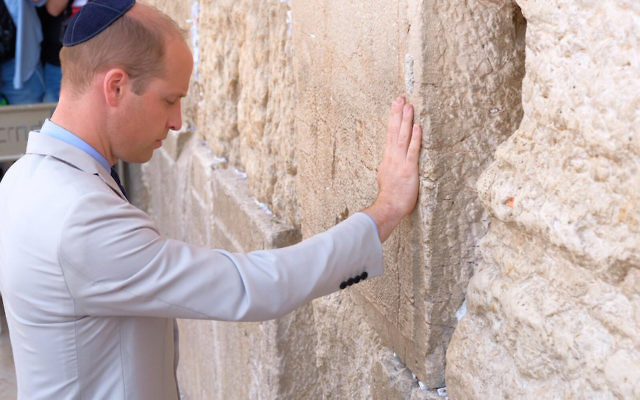Eretz Isroyal – William at Kotel
As Prince William placed his hand on the Western Wall yesterday, he made history. Again.
This was the most significant, public, and poignant homage to Jewish history by the royal family. According to his itinerary the Kotel is in “occupied” land, but that didn’t mar the visit.
As I stood there, three metres away from the Duke, I watched him respect every possible Jewish sensitivity. He wore a kippah as expected, had two rabbis escort him to the Wall, and even took his first few steps away from the stones walking backwards, a sign of deference that most visitors do not observe.
William looked thoughtful as he stood by the Kotel. He was surrounded by thousands of onlookers, but appeared to block out all the commotion for a moment of personal reflection.
The scene at the Wall couldn’t have been more different from the Church of the Holy Sepulchre, where he headed next.
As I walked to the church through the Arab quarter, a few steps behind the Duke and Chief Rabbi Ephraim Mirvis, some Palestinians cheered.
The church was calm and quiet, unlike the Kotel, which was packed with worshippers, as Thursday is one of the busiest days at the Wall when people make bar mitzvahs. Families hire drummers, trumpeters and singers to dance them in to the site, and honour the bar mitzvah boys during services by the wall that often involve wailing, singing, and the throwing of sweets.
The Duke’s arrival at the Wall was kept under wraps until moments before it happened, so all of this commotion was underway. It took a few moments for many of the worshippers to realise what was happening, and try to catch a glimpse of him. Some debated whether they should recite a special blessing for seeing royalty (the answer is no, it’s only recited on reigning monarchs).
William came to the Kotel straight from the nearby mount which is a major flashpoint in the Israeli-Palestinian conflict. He was on Temple Mount, or Haram esh-Sharif to Arabs, and visited the al-Aqsa Mosque.
Of all the people I talked to today Flip Florin, a Romanian Orthodox priest who was in the church during William’s visit, captured the mood the best, saying that he set an example by hopping between religious sites and showing respect for all of them.
“He chose to come here because of Jerusalem’s importance to Jews, Christians and Muslims, and he makes an important point by going between the sites one after another,” said Florin.
William has a good source of inspiration for respecting different — his great grandmother Princess Alice. He went to her grave on the Mount of Olives, proud of her acts to save Jews during the Holocaust. He placed flowers on her grave.
Soon after leaving the Old City, William was on a plane out of Israel., seemingly scheduled so that he would land in time for the World Cup game between England and Belgium. He left people with an impression that his visit here had an impact on him — and he certainly left an impact on Israelis and Jewish people.
“Today we experienced a moment of history which will live long in the memory of Jews around the world,” said Mirvis, with had been at the Wall with him, just before William departed.
“The Western Wall stands at the epicentre of our faith. To see the future Monarch come to pay his respects was a remarkable gesture of friendship and a sign of the Duke’s regard for the sanctity of Jerusalem.”
NATHAN JEFFAY


comments